Objections to Implement Learning Roadmap
 Management had recognised that business continuity management (BCM) is a key component of an enterprise risk management programme. This is evident in view of the pandemic outbreak globally.
Management had recognised that business continuity management (BCM) is a key component of an enterprise risk management programme. This is evident in view of the pandemic outbreak globally.
Nevertheless, It is not uncommon that employees ranging from senior management to the general staff members, supply chain partners and clients are unaware of the existence of the BCM programme or their role within the BCM effort.
Does it beg the question that the confidence that this BC plan is supposed to ensure the survivability of the organisation is workable if key stakeholders are unaware of their roles, response and recovery responsibilities?
This lack of focus to set the correct objective has resulted in the wasted investment in both time and resources devoted to the initial planning effort. So why do organisations continue to place training and competency building at the end of a long list of priorities?
Executive Management strongly feels that the costs associated with BCM training, competency development and delivery exceed the benefit but at the same time, they felt that the organisation does not have the expertise and resources to develop the necessary training content.
These include the lack of dedicated BCM know-how and budget to have the development and delivery of the training outsourced. The situation is worsened when the appointed staff members are part-timers and the business areas they are tied to complain about the need to prioritise their primary role in the business area. Hence, participating in training becomes a pesky subject and too time-consuming and, therefore, allocated a low priority.
Where Do You Start as a BCM Practitioner?
A budding and proactive BCM professional may like to begin by designing a competency framework based on the core capabilities. It is designed such that each practitioner should possess a particular level of competency at each stage of the role, authority, seniority and assigned responsibilities within the organization. This professional should consider the skill level that each core and specialist competency should have based on each level of seniority.
Organization BCM Maturity
One of the approaches that a BCM professional can benchmark its BCM programme is by using the BC Maturity Model (BCMM). It ranges from the simple three levels to Virtual Corporations’ (2003) six levels of organizational BC competency maturity as shown below.
| Level | 1 | 2 | 3 | 4 | 5 | 6 |
| Maturity Models Level | Self Governed | Supported Self Governed | Centrally Governed | Enterprise Awakening | Planned Growth |
Synergistic |
| Athlete Analogy | Able to Crawl | Able to Walk | Able to Run | "Fit" Runner | Competitive Runner | Olympic Runner |
BC Maturity Model with Analogy to An Athlete (Virtual Corporations, 2004)
It is crucial that organisations map and align their training competency to their desired organisation competency. This speed of BCM implementation and continuous improvement will allow the necessary resources and capabilities to be developed based on the approved pace of maturity of the BCM programme. The key is to move organisational competency from “At Risk” to “Competent” performers as shown below.
|
Maturity Models Level |
Level 1 Self Governed | Level 2 Supported Self Governed | Level 3 Centrally Governed | Level 4 Enterprise Awakening | Level 5 Planned Growth | Level 6 Synergistic |
| Corporate Competencies | General Attributes of an Organization at Each Maturity Level | |||||
| Leadership | VL | L | M | H | H | H |
| BC Awareness | VL | L | L | M | H | H |
| BC Program Structure | VL | L | L | M | H | H |
| Program Pervasiveness | VL | L | L | L | M | H |
| Metrics | VL | L | M | M |
H |
H |
|
Recourse Commitment |
VL |
L |
M |
H |
H |
H |
|
External Coordination |
VL |
L |
L |
M |
H |
H |
|
BC Programme |
VL |
L |
M |
H |
H |
H |
BCMM Maturity Model and the Related Corporate Competency (Virtual Corporations, 2003)
Competency
A competency (WSQ, 2010) is a measurable set of knowledge, skills, and attitudes that an individual needs to perform a task effectively. It is not an entire job and in most cases, several competencies are necessary for a job. As competency is task-based, an individual may need to transfer the competencies to new situations and environments.
A competency (IIA, 2013) is also the ability of an individual to execute a job or task suitably. This consists of a set of defined knowledge, skills, and behaviour. The competency framework provides a structured guide, enabling the identification, evaluation, and development of competencies in individual BCM professionals.
Competency-Based Training
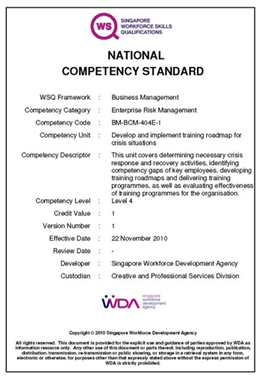 In Singapore, the government had developed a series of competency standards (Singapore Workforce Skills Qualifications, 2010) are reference documents that capture the most relevant information about a particular job task of a job role in a given industry setting.
In Singapore, the government had developed a series of competency standards (Singapore Workforce Skills Qualifications, 2010) are reference documents that capture the most relevant information about a particular job task of a job role in a given industry setting.
In the context of this article, the competency standards for BCM are available using the Singapore Workforce Skill Qualification (WSQ).
A standard competency documents the expected work performance outcomes, the expected level of performance, the knowledge that supports the delivery of job performance outcomes and the work contexts under which the job performance outcomes are to be delivered, according to industry agreed on minimum standards and expectations.
In other words, a competency standard states what an individual can do, what an individual should know, when and where an individual would perform his job role and how well an individual would perform in his job role.
Competency Descriptor: Develop and Implement BCM Training Roadmap
A competency standard from the Singapore Workforce Skill Qualification (2010) echoes exactly the needs of the standard competency document.
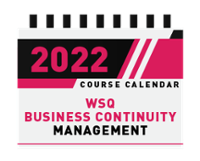 Performance criteria or performance statements from Singapore’s Workforce Development Agency (WDA) refers to the expected work statements of performance outcomes or behaviours and the expected level of performance to be demonstrated by a competent individual. Do note that WDA is now re-organized into two statutory boards, SkillsFuture Singapore (SSG) and Workforce Singapore (WSG).
Performance criteria or performance statements from Singapore’s Workforce Development Agency (WDA) refers to the expected work statements of performance outcomes or behaviours and the expected level of performance to be demonstrated by a competent individual. Do note that WDA is now re-organized into two statutory boards, SkillsFuture Singapore (SSG) and Workforce Singapore (WSG).
BCM Learning Roadmap
The implementation of BCM is to improve an organisation’s resilience has seen a growing number of organisations having an increased awareness of the importance of BCM. Great strides have been made in incorporating BCM practices in their daily operations. This is apparent from the growing number of companies getting their organisational BCM certification or getting a team set up to ensure that they have a BCM in place and have the BCM plan aligned to the worldwide BCM standard, the ISO 22301 BCMS standard.
Before embarking on their BCM journey and upon initial analysis, it is observed that organisations fall into two groups; the first group do not actively monitor and manage their BC programmes, while the other group, despite acknowledging the importance of managing it, find that progress is difficult beyond the initial year of implementation.
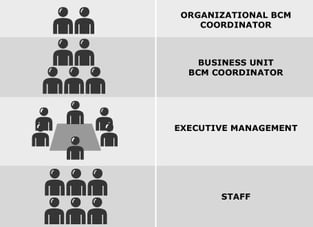 While both groups understand the need to manage and upkeep their programme and to keep it relevant to the organisation, most are at a loss as to what needs to be done and how it is done. This document helps to address this issue and serves as a guide for the various parties within an organisation to choose their BC training journey.
While both groups understand the need to manage and upkeep their programme and to keep it relevant to the organisation, most are at a loss as to what needs to be done and how it is done. This document helps to address this issue and serves as a guide for the various parties within an organisation to choose their BC training journey.
This roadmap first identifies and clarifies the roles and responsibilities of different parties within the organisation.
Once a personnel’s role has been identified, references are made to each roles’ competency needs and its recommended training journey. This roadmap also acknowledges the need for training of general staff that may not be directly involved in BCM but nonetheless; need to know their role in times of a disaster.
Business Continuity Roles
The level of BC involvement in an organisation varies among the different roles. For ease of reference, the four main roles are identified as; Organisation BCM Coordinator, BU BCM Coordinator, Executive Management and General Staff Members. Each BC role and responsibility is as shown below.
BCM Roles and Responsibilities
| BC Roles | BC Responsibilities | |
|
Executive Management |
 |
|
| Organisation BCM Coordinator |  |
|
| BU BCM Coordinator |  |
|
| Staff Members |  |
|
BC Roles and Responsibilities
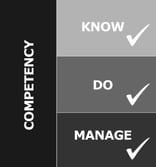 These roles are identified as they make up the most common groups of personnel in an organisation. By studying the responsibilities associated with each role, we can then identify the requisite knowledge required of them. This level of competencies can be broadly categorised into three levels, namely; ‘Know’, ‘Do’ and ‘Manage’.
These roles are identified as they make up the most common groups of personnel in an organisation. By studying the responsibilities associated with each role, we can then identify the requisite knowledge required of them. This level of competencies can be broadly categorised into three levels, namely; ‘Know’, ‘Do’ and ‘Manage’.
BCM Body of Knowledge
These levels of competencies are supported by the globally recognised published set of BCM Body of Knowledge (BoK) or subject areas that make up the various stages of BCM Planning.
Below figure provide the BoK to support the knowledge to be acquired by a typical BCM professional.
The next figure depicts how the BCM BoK supports the competency level moving from “Know” to “Manage.”
BCM Institute’s BCM Body of Knowledge
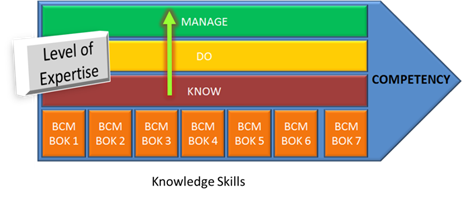
The Competency Level and the BCM Body of Knowledge (BoK)
BCM Planning Methodology
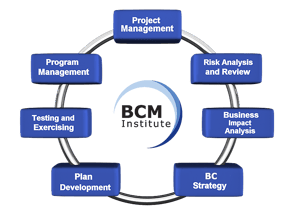 The BCM BoK is aligned to BCM Planning Methodology. This alignment is to ensure competency in any BCM implementation.
The BCM BoK is aligned to BCM Planning Methodology. This alignment is to ensure competency in any BCM implementation.
The next section will further discuss the learning needs of each role. We will start off with the personnel with the most BC responsibility i.e. Organization BCM Coordinator, followed by BU BCM Coordinator, Executive Management and lastly, General Staff Member.
Reference
IIA. (2013). IIA Global Internal Audit Competency Framework. Competency Framework, 1–2. Retrieved from https://www.iia.org.au/sf_docs/default-source/learning-development/Internal_Audit_Competency_Framework.pdf
Singapore Workforce Skills Qualifications. (2010). Interpretation of WSQ competency standards for training and assessment. National Competency Standard: Singapore Workforce Development Agency, 1–70.
Singapore Workforce Skills Qualifications. (2012). Develop Competency-Based Assessment Plans. National Competency Standard: Singapore Workforce Development Agency, 1(Oct), 1–52.
Virtual Corporation. (2003). Business Continuity Maturity Model. Virtual Corporation, 1–63.
More Information About Blended Learning BCM-5000 [BL-B-5]
To know more about our blended learning program and when the next course is scheduled, feel free to contact our friendly course consultant colleagues via sales.ap@bcm-institute.org. They are the BL-B-3 Blended Learning BCM-300 ISO22301 BCMS Implementer and the BL-B-5 Blended Learning BCM-5000 ISO22301 BCMS Expert Implementer.
![FAQ [BL-B-3]](https://no-cache.hubspot.com/cta/default/3893111/b3824ba1-7aa1-4eb6-bef8-94f57121c5ae.png) |
Please feel free to send us a note if you have any of these questions to sales.ap@bcm-institute.org |
 |










